My first thought in the spring is when is the ground going to hit 45F? This seems to be the temperature that I like to get thinking about peas and other early plants!
However, there is a lot more than thinking about temperature when you think about planting.
- Whidbey Island contains several areas of differing weather.
- Think about the changes in weather when driving from Clinton to Deception Pass. I have had days where it goes from snow and rain to dry, and back to rain again.
- You can be near the weather and be a good fifteen degrees above your neighbor who is on the other side of a ridge from you.
- You can sit on one side of a fog bank while your neighboring farm gets socked in for days throughout the summer.
- And - you can plan on a year with limited rainfall, and receive all of your rain at the "wrong time".
Rain Shadow…
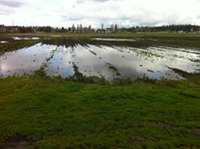
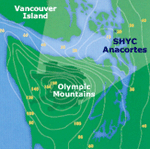
- Though not seen through much of the world rain shadows do exist where air is forced to rise up over and to move around objects like mountains. As the air rises it cools and releases moisture, then on the opposite side of the mountain there is a spot that does not receive as much moisture.
- However, sometimes the weather comes a different direction and you receive more rain than you were expecting…
Weather Forecasting and Weather Data…
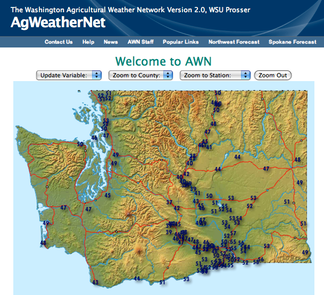

I usually use long range weather forcasting provided by NOAA for seasonal choices, and for daily weather data I use AgWeatherNet for data for the last 24 hours . This data includes soil temps, precipitation, wind directions and speeds.
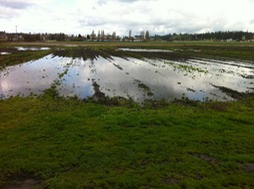
Working Around the Weather and the Seasons…
We have put into practice several ways to extend our growing season and to work around weather patterns.
In the garden we treat our season like Breed's Hill, and we are the Americans heading for the high ground.
- While many low parts of our land can be quite wet during the spring, our high ground will often be workable.
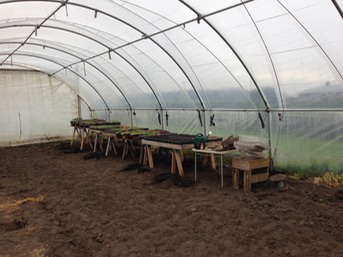
We also work to germinate early using electric blankets covered with thick visquine plastic, and a hoop house that acts as a large cold frame during the spring.
We also use the hoop house to store items that need to dry/cure during the fall like winter squash and dry beans.
When we built our hoop house it was a kit that I purchased from Farmtek.com which is a company that provides an incredible amount of farm related technology, but not always the best plans or directions for building items.
It was a real struggle to read through the directions for the hoop house, and quite a few of the materials supplied with the kit were actually quite destructive to the hoophouse during wind.
With the recent re-covering of our hoop house I took the opportunity to modify the plans to no longer include the rope reccomended by the manufacturor and to remove completely their "clip" system and replace it with the "wiggle wire" system you can see on many of the other hoop houses on the prairie.
Our hoop house has a roll up front and back which allows me to bring tractors and trailers into the structure making it quite versitile.
The benefits of using a hoop house are:
- that the soil temperature is increased
- You can plant all year around
- With floating row cover inside as well you can really protect plants
- With a big enough door you can get equipment in.
Some of the down sides of hoop houses:
- the soil can get very compacted
- you must water
- temperatures must be monitored and payed attention to. Some days the temps can reach 105 F by 8AM.
- Can be perforated, torn, ripped...
Floating Row Cover
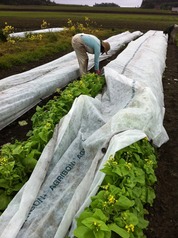
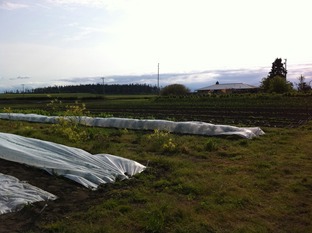
Another way we help our young plants is through the use of floating row cover sometimes called ReMay, or Agribon (these are the company names that make the product).
We use a clip and stake system for our row cover however others bury the edges and some use sandbags to keep them down.
The benefits of using floating row cover are:
- that the soil temperature is increased by a few degrees,
- the plants have a warmer environment to grow,
- they are somewhat protected from frost or freeze,
- they are more protected from wind.
- The row cover allows light and moisture to pass through.
Some of the down sides of row cover:
- that it needs TLC to be used again,
- it hides a crop from daily view, which may mean you loose some items to rapid maturity,
- and it can blow away.
Germinating Plants Indoors
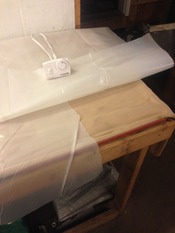
Getting a head start on planting in the spring can be a big advantage in getting early plants going. After visiting "The Root Connection", a 500 member CSA in Redmond, WA, we learned about using electric blankets as effective heat mats for germinating seeds.
We have had trouble with starts and found that a sprinkling of cinnamon over the top of the soil helps with fungi and damping off. Cleaning tools, pots, utilizing good seed starting mixes and wearing gloves are all ways to help prevent this.
